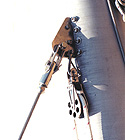
The
Boat |
|
The Owners John Atkisson was a federal government lawyer when he retired in the Spring of 2005 to begin Kestrel’s Atlantic circle. He had first sailed in San Francisco Bay at age 13. His wife, Kathy Sawyer (Atkisson), was a reporter for the Washington Post for 28 years. She left the Post in 2004 and has continued to work as a free lance writer and author. [See www.kathysawyer.com] UPDATE: >>>>>>>>>>>>>>>>>>>>>>>>>>>>>> In August, 2009, after returning from a summer of sailing Kestrel in Maine, John was diagnosed with terminal lung cancer. He kept sailing through that fall with family and friends. Upbeat to the end and busily maintaining Kestrel in hopes of “at least one more season on the Bay,” John died at home on February 19, 2010.
A LOCAL LIFE: JOHN ATKISSON, 68 John Atkisson; After law career, he sailed across Atlantic.
John Atkisson had a 32-foot sloop, Kestrel, harbored on the Chesapeake Bay, which he loved cruising with his wife. (James A. Parcell/for The Washington Post) By Bart Barnes John Atkisson was at home and at ease in
a congressional hearing or a courtroom, in the offices of a federal
bureaucrat or on the deck of his sailboat. He earned his living as a
lawyer, but his friends would tell you that under his pinstripes was
the soul of an 18th-century seaman.
|
|
'Kestrel' is a 1976 32-foot Bristol sloop, continuously improved over 28 years by owners, always with serious blue water work in mind. After a shakedown cruise from Chesapeake Bay to Bermuda and back in 2001, Kestrel was prepared for more ambitious plans. In the late Spring of 2005, she set sail for Ireland, which was the first leg of a 2 - year Atlantic circle. Since that first trans-Atlantic passage, Kestrel has toured Scotland (the lower Hebrides in June and July of 2006), then, after a brief return to Ireland, Spain (La Coruna), Portugal, Madeira, the Canary Islands, then finally back across the Atlantic to the Caribbean. For that classic trade-wind passage in December 2006, John single-handed Kestrel the 3000-odd nautical miles from Tenerife in the Canaries to Martinique, where Kathy came aboard for the ensuing five months of cruising up the Antilles and Bahamas before the final leg home from Green Turtle Cay to Beaufort Inlet in North Carolina, thence up “the ditch” to Chesapeake Bay. Kestrel has been at her home port in Deale, Maryland, since June, 2007.
"KESTREL" SOLD The boat was listed for sale on March, 2 2011. Sale was completed on March, 12. She now has a new home in Florida.
Bristol 32 Specifications (1976)
|
The Cape Horn Windvane people, thought enough of Kestrel’s installation to include it in their Owner’s Manual:
"Ideal size of the
servo-pendulum. Experience has shown
that the wetted area of servo-pendulum needed to steer at 2-3 kts to
be somewhere between 8 and 12 % of the yacht’s rudder area. Closer
to 8 for a high aspect-ratio, partially balanced rudder steering a well
balanced boat, and closer to 12 (or more) for a low aspect ratio rudder,
on a boat that is not so well balanced, or has a wheel steering system
with a lot of internal friction. We normally take into account the yacht’s
rudder dimensions and the height of the horizontal axis above the waterline
in determining the length of the servo-pendulum for a given boat, but
if you find that your pendulum does not generate adequate power to steer
your boat at slow speeds, please contact us and we will provide you
with a longer one. From Cape Horn Owner’s Manual, © Yves Gélenas
|
SELECTED 'KESTREL' IMPROVEMENTS
Please click on the thumbnails to enlarge
PRE-ATLANTIC-CIRCLE CRUISE PHOTOS
Please click on the thumbnails to enlarge
| 1 | Kathy at the helm, reaching toward Bermuda, 2001 | |
| 2 | Running home from Bermuda under the chute, 2001, crewman John Rayburn in the foreground. Hours after this photograph was taken, with the chute still up, Kestrel was hit by a whale. |
|
| 3 | Beautiful Fall day on the Chesapeake, a light air down-bay run toward Solomons Island | |
| 4 | The Pride of Baltimore crosses Kestrel’s bow, Chesapeake Bay, October, 2003 |


































